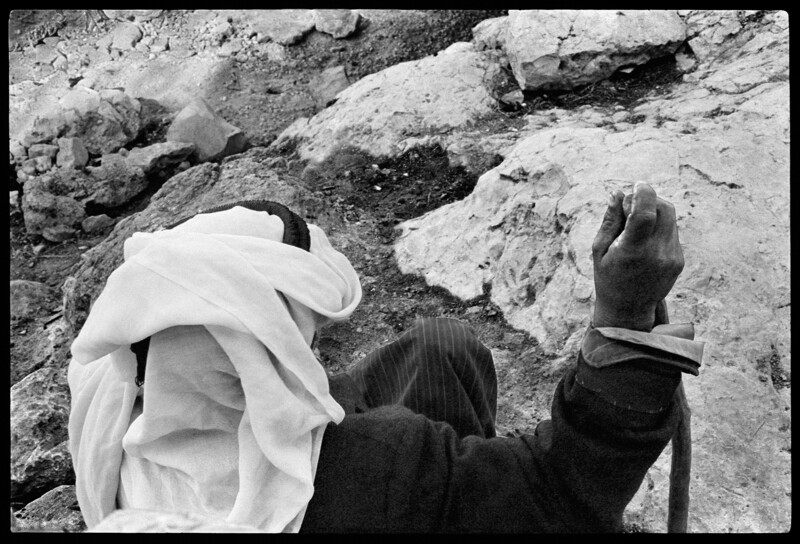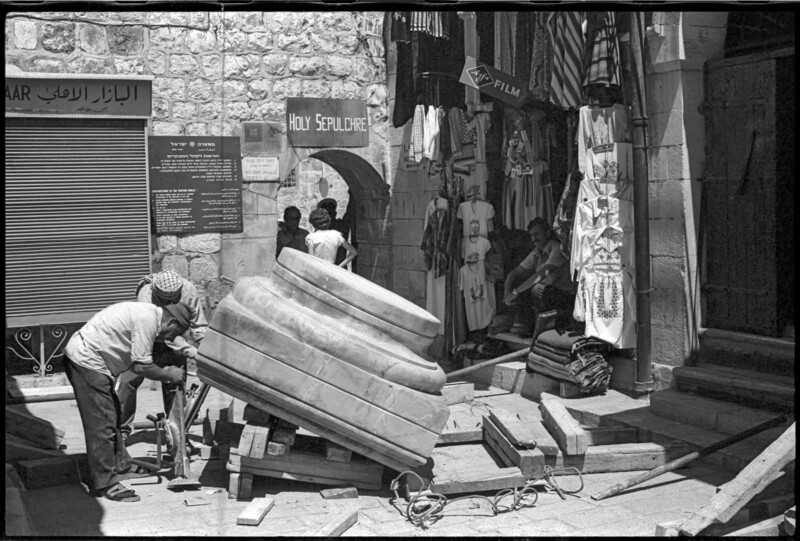The Electronic Intifada 3 October 2019

East Jerusalem, May 1979
It may seem odd to return to a place one has never been. But as an American of Palestinian origin, that is precisely the feeling I had when I “returned” to Palestine in 1978 as a recent college graduate.
I applied to the Hebrew University’s foreign student program, and they accepted me based on my straightforward premise: “My background is Palestinian Arab … My objective in going to Israel is to observe the Middle East situation from the Israeli perspective.” I went with high hopes and bags full of naivete.
My family was not pleased. My uncle remarked: “Do you think you are going there to play Kissinger?”
My 18 months in the country hardly caused a ripple. I don’t believe that any of the Israelis I spoke with, got to know, or befriended went on to become a “mensch” towards Palestinians.
My presence there did, however, provide the only opportunity for my mother to return to the country, see her old home in Haifa and meet relatives not seen since her exile in 1948.
Unlike the fog of memory, these images feel solid, like a stone. Although they may appear timeless, or from another era, they are not nostalgic.
They show Israelis and Palestinians living beneath the banner headlines of the times: Egyptian President Anwar Sadat’s visit to Jerusalem, US President Jimmy Carter’s Camp David accords, the origins of the Israeli settler movement and of course, the Iranian Revolution.
The text that accompanies these photographs are adapted excerpts from a journal I kept at the time. Today it reads like a recently delivered collection of letters that I had written to my future self.
My work over the last 10 years has focused primarily on remembering and documenting. Both are part of the Palestinian struggle to regain control of our narrative.
Najib Joe Hakim is a San Francisco-based photographer whose two previous projects Home Away from Home and Born Among Mirrors also focus on the Palestinian diaspora experience. He is currently a Political Art Fellow at the Yerba Buena Center for the Arts.

West Jerusalem, August 1978
He looks but does not see.
.ينظر ولكنه لا يرى
He hears but does not understand.
.مثل الأطرش في الزفة
Ask about the neighbor before the house.
.اسأل عن الجار قبل الدار
The old terrorist Menachem Begin, now prime minister, wants to give the Palestinian people autonomy, but not over their land! Where do they come up with this stuff? The very essence of autonomy is zapped when the “autonomous” people cannot rule over the land they live on.

West Jerusalem, August 1978
Shabbat is almost here again. People are doing their last-minute shopping for their Sabbath meal. Tonight, I will be joining new friends for my first Shabbat dinner.
One of the primary reasons I am here is to get to know Israelis. I requested an Israeli roommate and one was assigned to me. I arrived before him. He finally got here at 7 am, while I was still in bed.
I sat up, introduced myself. My roommate looked at me speechlessly, turned and walked out with his bags, never saying a word. I was told by someone in the residence office that he came in yelling that he would not share a room with an Arab. Wow! Is that the way it’s going to be? They always told me that we were the bad guys.
The first two Hebrew expressions I learned I heard very clearly. The first was easy: shalom or “peace,” used as a standard greeting like “hi.” The second was darker. An Israeli student on the campus yelled out, “Aravi tov, Aravi met!” So I asked someone what that meant. “A good Arab is a dead Arab.” Not an expression to forget, for sure.

Jerusalem-Ramallah bus line, June 1979
This morning, after my run, Ali and I walked a little in East Jerusalem before catching a bus to Ramallah. East Jerusalem is another country altogether from the western part of the city. Arabs, Arabic language and Arabic food everywhere. The air is rich with spice – not the gray European feeling I get in West Jerusalem. I felt comfortable and at home!
It was a short ride to Ramallah, 20 minutes maybe. We walked around town and ate some ful [a dish made with fava beans]. We bought a few things, and Ali hopped a bus for Jenin to see his family. I returned to Jerusalem.
Before leaving, Ali invited me to visit his home sometime. Since I am more familiar with middle-class Christian Lebanese customs and he is working-class Muslim, I asked what the appropriate way to greet his wife would be. Shake hands, kiss her cheek, etc.? Culture smack: he said I would never see his wife!

Damascus Gate, East Jerusalem, January 1979
A tall, blonde professor at Hebrew University, a recent immigrant from Canada and a supporter of the settler movement Gush Emunim was upset that Israel, as he put it, “let you back in.” He said this without any concern for etiquette, walking off with his book-filled satchel and his kippah sliding off his head.
Zionist animosity toward this returning Palestinian is like the blue shadow sloping down Jerusalem’s hills, defining the shape of things. Despite this, I have never felt so at home as I do here. Every breath feels like a charge of energy. Life here for me is as natural as waking up in the morning.
I walk to the Old City and get some warm knafeh and freshly squeezed carrot juice as if I’ve done it my whole life.

Outside Jerusalem’s Old City walls, May 1979
Ninety-year-old Iskandar, in Lydda, knew my grandfather, the one who died aged 33 when Dad was 3 years old. I asked him to tell me about my ancestor – in Arabic, of course!
I sat beside Iskandar, who began by saying old Najib was a big dude, even in high school in Jaffa. But there was a guy in town who was twice as big as Najib. The kids at school taunted this Jaffa giant, saying Najib could throw him down.
All huffed up, the giant confronted Najib, who declined the challenge because the other guy was twice his size and age. The giant goaded him. So our hero picked the giant up and slammed him to the ground.
He got back up, dusted himself off and claimed it wasn’t fair because he wasn’t ready. So Najib smashed him down again and even a third time! Unfortunately, this big dude was no ordinary bloke, but a mafioso. His gang threatened the school. So Najib was forced to leave.
That’s when Najib began drinking heavily and carried two pistols in his belt as he cruised the dusty streets of Jaffa. He was cut short in his prime after years of boozing.

Old City of Jerusalem, January 1979
Palestinians in both Israel and the West Bank have warm hearts but hard heads. I wonder when they will stop relying on outsiders like the Palestine Liberation Organization (PLO) and take matters into their own hands.
Police kicked out my friend Nasir and five other Arab students from the Hebrew University for sending a telegram of solidarity to the PLO in Damascus. They are now each in his own village and must report twice daily to a specified police office. In their telegram, they allegedly promised to help the struggle from within Israel.

Old City of Jerusalem, February 1979
Today the Israelis celebrate “One Jerusalem” – the “reunification” of the city under Israeli control. These guys, from Brooklyn, Canada, Russia, Argentina, etc., sing and dance and pray out in the Old City streets. Behind shuttered windows, the city’s indigenous population sits in a dim, simmering silence. They are under the watchful eyes of the Israeli “Defense” Forces. This is what a reunited Jerusalem looks like.

Metula, on the Lebanon-Israel boundary, April 1979
I spent April hitchhiking the perimeter of the country with Mark. Starting in Jerusalem, we aimed for Gaza and Jaffa, north to Haifa, Ras al-Naqoura, east along the Lebanese border, south through Tiberias, Safad, the Galilee, Nazareth, Nablus and more.
In the border town of Metula, we approached the so-called “Good Fence.” Israel allows Lebanese Maronite Christians to pass through the gate as part of their support for the proto-fascist Christian militias. Alas, fascists and Jews find common cause.
A hand-written sign on the Israeli side quotes the Biblical passage, “Nation shall not lift up sword against nation.” It is through this gate that the nation of Israel sends its military to attack the nation of Lebanon.
Two twenty-something Israeli soldiers with Uzis guarded the fence. I told them that my grandmother came from the Lebanese town of Marjayoun under that small mountain and asked if they would allow us to cross. “Sure we will.” With a hint of a smirk, the other added, “But we can’t guarantee we’ll let you back in.”

Village in the Galilee, April 1979
In the Galilee, Mark and I met an elderly Jew from Tunisia who was living alone in a formerly Palestinian village, raising his chickens in the abandoned mosque. Later we met some cute Palestinian girls in another village that had not been abandoned.

Outside Herod’s Gate, Old City of Jerusalem, May 1979
Today I saw a fellow about 20 years old in the Old City. There was nothing special about him except his red T-shirt read “Filastin” or “Palestine” in Arabic.
I didn’t think about him again until after lunch when an Israeli army jeep passed by me and stopped. In addition to the driver, there were three soldiers with machine guns – and the “Filastin” fellow. The soldiers were about his age. He was trying to be brave but was visibly nervous. One of the soldiers dropped his black boot on the young Arab’s lap.
The incident reminded me of an encounter with New Orleans police during Mardi Gras where the cops forced a group of African American teenage boys to sit in their urine in an alley before searching and interrogating them. Those cops were nothing more than a gang of toughs wearing uniforms and carrying guns.
It was like the government giving one of two rival gangs uniforms and weapons and sending them out to keep the streets “clean.” Well, of course, the first ones they go after are members of the rival gang. Same thing here in Filastin, except you don’t even need to pee in an alley to be harassed.

Gaza Strip, April 1979
Summer passed like an afternoon nap. I find myself back in America. My last days in Israel were as expected: intense, rushing from family to family, friend to friend. I try to comprehend what I achieved there. I explored the country top to bottom, east to west. I sank myself into the land, history, people.
The greatest year of my life. The best thing I ever did. These sound like platitudes but feel right nonetheless. An intense year of intellectual search and growth, personal triumph and despair. The move from ignorance to knowledge. And now, I know. I know there will be a major war soon.
Here in the US, many think Palestine borders Israel. On a TV game show, it was even worse: The contestant was baffled by the question, “What was Israel’s former name and which colonial power ruled over it?”
My life in Jerusalem doesn’t feel like a dream at all. It still feels real, as if I could easily go back tonight and pick up where I left off. But I realize I can’t go back. Already much has changed. It was only yesterday I was walking through Damascus Gate. But I can’t go back.


